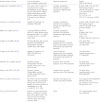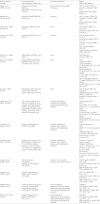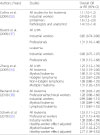Abbreviations
ACGIH
EPA
EU CLP
IARC
ILO
LHM
NCI
NPC
NTP
TLV-TWA
Background
Methods
Results
Use and exposure in South Korea
Table 1

Table 2

Table 3

| Authors (Years) | Subjects and measurements |
Formaldehyde concentration, ppm Geometric mean (range) |
|---|---|---|
| Park et al., (1998) [13] | 19 workers in 9 histological laboratories in each hospitals. Personal and area sampling to assess TWA and STEL |
TWA (8 h) Personal 0.31 (0.02–3.86) Area 0.61 (0.08–1.49). STEL (15 min) Personal 1.88 (0.59–5.01) Area 1.42 (0.31–4.24) |
| Park et al.,(2006) [14] | 80 students in a gross anatomy laboratory in a college of medicine. Area sampling at 4 spots 5 times each |
TWA (8 h) Area 1.51 (0.26–3.91) |
| Kim et al. (2009) [15] | 48 workers in endoscopy units in 4 hospitals. Personal samplings to assess TWA and STEL. |
TWA (8 h) Personal 0.056 (0.003–0.923) STEL (15 min) Personal 1.428 (0.103–14.773) |
| Lee et al., (2012) [16] | In curling and compounding process of two tire plants, 12 personal sampling to assess TWA. |
TWA (8 h) Personal 0.029 (0.027–0.029) (highest within 4 spots) |
| Yoo et al.,(2014) [17] | Workers handle medium density fiberboard and veneer in a furniture manufacturing factory. Air concentration of formaldehyde handling wood glue and wet veneer at room temperature, 100 °C and 150 °C | (Handling wet veneer at 150 °C, 2.70 ppm) |
| Gu et al., (2014) [18] | 62 nurses in 8 ambulatory care units in 2 hospitals. Personal samplings to assess TWA. |
TWA (8 h) Personal 0.023 (0.001–0.258) |
Epidemiological studies
NPC
Table 4

| Authors (Years), Country |
Cohort description Type of analysis (cohort size) |
Exposure assessment |
Results SMR or RR (95% CI) |
|---|---|---|---|
| Hauptmann et al.(2004), USA [19] | The cohort with 10 plants of manufacture of or using formaldehyde by the National Cancer Institute from 1966 to 1994; Standardized mortality (25,619 workers; 22,493 men, 3126 women) and Relative risks | Duration; quantitative estimates of cumulative, average and highest peak exposure |
8 death, SMR 2.10 (1.05–4.21) Peak exposure (ppm) ≥4.0 RR 1.83 (p-trend < 0.001) Cumulative exposure (ppm-year) 1.5–< 5.5 RR 1.19, ≥5.5 RR 4.14 (p-trend = 0.025) |
| Freeman et al. (2013), USA [20] | Update of Hauptmann et al.(2004), 1966–2004 | Duration; quantitative estimates of cumulative, average and highest peak exposure |
9 death, SMR 1.84 (0.84–3.49); Peak Exposure (ppm) ≥4.0 RR 7.66 (0.94–62.34) (p-trend = 0.005) |
| Marsh et al. (2005), USA [21] |
Computed SMRs and RRs for each of 10 study plants and by plant group (Plant 1 (n = 4261) vs. Plants 2–10 (n = 21,358)). 1966–1994 |
Duration; quantitative estimates of cumulative, average and highest peak exposure |
Plant 1 6 deaths, SMR 10.32 (3.79–22.47) plant 2–10 2 deaths, SMR 0.65 (0.08–2.33) |
| Coggon et al. (2003), UK [23] | Chemical factories that used or produced Formaldehyde; Standardized mortality (14,014 men); 1941–2000 | Level of exposure (background, low, moderate, high); among highly exposed, time period and duration of exposure | One death from nasopharyngeal cancer (2.0 expected) |
| Coggon et al. (2014), UK [24] | Update of Coggon et al., (2003). (14,008 men); 1941–2012 | Level of exposure (background, low, moderate, high); among highly exposed, time period and duration of exposure | One death from nasopharyngeal cancer (1.7 expected) |
| Pinkerton et al. (2004), USA [25] | Garment industry; Standardized mortality (11,039 workers; 2015 men, 9024 women) | Duration, time since first exposure, year of first exposure | No death from nasopharyngeal cancer (0.96 expected) |
| Meyers et al. (2013), USA [26] | Garment industry; Standardized mortality (11,039 workers; 2015 men, 9024 women) | Duration, time since first exposure, year of first exposure | No death from nasopharyngeal cancer (0.96 expected) |
| Siew et al. (2012), Finland [27] | All Finnish men born between 1906 and 1945 and employed during 1970, Finnish Cancer Registry for cases of cancers of nasopharynx (n = 149) (n = 30,317). 1971–1995. | Estimation of exposure by Finnish Job Exposure Matrix |
Any exposure to formaldehyde RR 0.87 (0.34–2.20) Any exposure to wood dust RR 0.66 (0.30–1.45) |
| Pira et al. (2012), Italia [28] | Workers of a laminated plastic factory in Piedmont, northern Italy. 2750 subjects (2227 men and 523 women) between 1947 and 2011, for at least 180 days. SMRs | None | No nasopharyngeal cancer was confirmed. |
Table 5

| Authors (Years), Country | Characteristics of cases and controls | Exposure assessment | Exposure categories | OR (95% CI) |
|---|---|---|---|---|
| Marsh et al. (2007), USA [22] | 7 incidental cases who died from nasopharyngeal cancer during 1945–2003; case was matched on exact age race, sex, and year of birth (±2 years) to four controls from the members of the cohort. | Evaluation of formaldehyde exposure while accounting for potential confounding or effect modification by smoking or external (non-Wallingford) employment. | Silver smithing | |
| Never | 1.0 (Ref) | |||
| Ever | 14.41 (1.30–757.8) | |||
| p-trend | 0.024 | |||
| Silver smithing or other metal work | ||||
| Never | 1.0 (Ref) | |||
| Ever | 7.31 (1.08–82.1) | |||
| p-trend | 0.047 | |||
| Olsen et al. (1984), Denmark [32] | 754 cases from the Danish Cancer Registry including 266 nasopharyngeal cancers; controls were 2465 patients with cancers of the colon, rectum, prostate and breast; frequency matched by sex, age (± 5 years) and year of diagnosis (± 5 years) | Record linkage with pension fund with compulsory membership; job title from Central Pension Registry; exposure assessed blindly as certain, probable, unlikely, unknown | Men | 0.7(0.3–1.7) |
| Women | 2.6(0.3–21.9) | |||
| Vaughan et al. (1986), USA [33] | 285 incidental cases identified by the local Cancer Surveillance System, aged 20–74 years, including 27 cases of cancer of nasopharynx; controls were 552 identified by random-digit dialing | Job–exposure linkage system based on industry and occupation, resulting in four categories: high, medium, low and background | Low exposure | 1.2 (0.5–3.3) |
| Medium or High | 1.4 (0.4–4.7) | |||
| Exposure years | ||||
| 1–9 | 1.2 (0.5–3.1) | |||
| 10+ | 1.6 (0.4–5.8) | |||
| Exposure scores | ||||
| 5~ 19 | 0.9 (0.5–5.7) | |||
| 20+ | 2.1 (0.6–7.8) | |||
| Roush et al. (1987), USA [29] | 173 nasopharyngeal cancers registered at the Connecticut Tumor Registry; Controls were 605 men who died during the same period, selected by random sampling without matching or stratification | Job title, industry, specific employment, year of employment, obtained from death certificates and city directories to determine occupation at 1, 10, 20, 25, 30, 40 and 50 years prior to death | Probably exposed for most of working | 2.7 (1.1–6.6) |
| life | 1.2 (0.5–3.2) | |||
| + exposure > 20 years before death | 2.9 (1.1–7.6) | |||
| + exposure to high level for some years | 4.0 (1.3–12.3) | |||
| + exposure to high level > 20 years before death | ||||
| West et al. (1993), Philippines [30] | 104 incidental cases (76 men, 28 women) histologically confirmed; 104 hospital controls matched for sex, age and hospital ward type and 101 community controls matched for sex, age and neighborhood | Occupational history; occupation classified as likely or unlikely to involve exposure to formaldehyde; duration of exposure; 10-year lag period; years since first exposure; age at start of exposure | Exposure year | |
| < 15 years | 2.7 (1.1–6.6) | |||
| > 15 years | 1.2 (0.5–3.2) | |||
| < 15 years (10-year lag) | 2.9 (1.1–7.6) | |||
| > 15 years (10-year lag) | 4.0 (1.3–12.3) | |||
| Vaughan et al. (2000), USA [31] | 196 men and women from five cancer registries, aged 18–74 years controls were 244 population based selected by random digit dialing, and frequency matched by sex, cancer registry and age (5-year groups) | Structured telephone interviews; occupational exposures assessed by a job–exposure matrix | Duration (years) | |
| 1–5 | 0.9 (0.4–2.1) | |||
| 6–17 | 1.9 (0.9–4.4) | |||
| > 18 | 2.7 (1.2–6.0) | |||
| p-trend | 0.014 | |||
| Cumulative exposure (ppm-years) | ||||
| 0.05–0.4 | 0.9 (0.4–2.0) | |||
| 0.4–1.10 | 1.8 (0.8–4.1) | |||
| > 1.10 | 3.0 (1.3–6.6) | |||
| p-trend | 0.03 | |||
| Armstrong et al. (2000), Malaysia [34] | 282 histologically confirmed cases of nasopharyngeal carcinoma in Chinese men and women from four centers who had lived in the area for > 5 years;One Chinese control selected by multistage area sampling per case, matched by age and sex |
Structured in-home interviews; Occupational exposures assessed by a job–exposure matrix |
Any (unadjusted) | 1.24 (0.67–2.32) |
| Any (adjusted) | 0.71 (0.34–1.41) | |||
| Hildesheim et al. (2001), Taipei [35] | 375 histologically confirmed hospital cases (31% women), aged < 75 years; 325 community controls, individually matched on sex, age (5 years) and district of residence | Structured in person interviews; occupational exposures assessed by an industrial hygienist | Ever exposed | 1.4 (0.93–2.2) |
| Duration | ||||
| 1–10 years | 1.3 (0.69–2.3) | |||
| > 10 years | 1.6 (0.91–2.9) | |||
| p-trend | 0.08 |
Table 6

| Authors, (Years) | Studies | Overall OR or RR (95% CI) |
|---|---|---|
| Collins et al.,(1997) [36] |
Cohort studies with reported expected deaths Industrial cohort studies Case-control studies All Studies |
1.6 (0.8–3.0) 1.2 (0.4–2.5) 1.3 (0.9–2.1) 1.3 (1.2–1.5) |
| Bosetti et al. (2008) [37] |
Hauptmann et al. 2004-plant 1 Hauptmann et al. 2004-plants 2–10 Industrial cohort studies |
9.10 (4.09–20.26) 0.64 (0.16–2.56) 1.33 (0.69–2.56) |
| Bachand et al. (2010) [38] |
Cohort studies (excluding single plant) Case control studies |
0.72 (0.40–1.29) 1.22 (1.00–1.50) |
Lymphohematopoietic malignancies
Table 7

| Authors (Years), Country |
Cohort description Type of analysis (cohort size) |
Exposure assessment |
Results SMR or PMR (95% CI) |
|---|---|---|---|
| Walrath et al. (1983), USA [39] |
Embalmers and funeral directors, PMR/PCMR (1132 white men); 1925–80 |
Time since first license, age at first license |
LHM 25 deaths PMR 1.21 Leukemia 12 deaths PCMR 1.19 Myeloid leukemia 6 deaths PCMR 1.5 |
| Walrath et al. (1984), USA [40] | Embalmers, PMR/PCMR(1007 white men) | Duration |
LHM 19 deaths PCMR 1.22 Leukemia 12 deaths PCMR 1.40 Myeloid leukemia 6 deaths PCMR 1.50 |
| Levine et al. (1984), Canada [41] | Embalmers, SMR(1413 men); 1950–77 | None |
LHM 8 deaths SMR 1.23 (0.53–2.43) Leukemia 4 deaths SMR 1.60 (0.44–4.10) |
| Stroup et al. (1986), USA [42] | Anatomists, SMR (2239 men); 1925–79 | Duration |
LHM 18 deaths SMR 1.2 (0.7–2.0) Lymphoma 2 deaths SMR 0.7 (0.1–2.5) Leukemia 10 deaths SMR 1.5 (0.7–2.7) CML 3 deaths SMR 8.8 (1.8–25.5) Other lymphoma 6 deaths SMR 2.0 (0.7–4.4) |
| Logue et al. (1986), USA [43] | Pathologists, SMR (5585 men); 1962–77 | None |
LHM SMR 0.48 Leukemia SMR 1.06 |
| Hayes et al. (1990), USA [44] | Embalmers/funeral directors, PMR(3649 white men, 397 non-white men); 1975–85 | None |
LHM 100 deaths PMR 1.31 (1.06–1.59) (White) 15 deaths PMR 2.41 (1.35–3.97) (Non-white) Myeloid leukemia 23 deaths PMR 1.61 (1.02–2.41) (White) 1 death PMR 1.06 (0.02–5.93) (Non-white) Other unspecified leukemia 17 deaths PMR 2.08 (1.21–3.34) (White) 3 deaths PMR 4.92 (1.01–14.36) (Non-white) |
| Hall et al. (1991), UK [45] | Pathologists; SMR; 4512 (data presented for 3872, 802 women, 3069 men); 1974–87 | None |
LHM 10 deaths SMR 1.44 (0.69–2.65) Hodgkin lymphoma 1 death SMR 1.21 (0.03–6.71) Leukemia 10 deaths SMR 1.5 (0.7–2) |
| Hauptmann et al. (2003), USA [46] | The cohort composed of 10 plants of manufacture of or using by the National Cancer Institute during 1966–1994; Standardized mortality (25,619 workers; 22,493 men, 3126 women) and Relative risks | Duration; quantitative estimates of cumulative, average and highest peak exposure |
Peak exposure (ppm) LHM 2.0–3.9 RR 1.71 (1.14–2.58) ≥4 RR 1.87 (1.27–2.75) (p-trend, 0.002) Leukemia 2.0–3.9 RR 2.04 (1.04–4.01) ≥4 RR 2.46 (1.31–4.62) (p-trend, 0.004) Myeloid leukemia ≥4 RR 3.46 (1.27–9.43) (p-trend, 0.009) |
| Freeman et al. (2009), USA [47] | Update of Hauptmann et al.(2003); 1966–2004 | Duration; quantitative estimates of cumulative, average and highest peak exposure |
Peak exposure (ppm) LHM ≥4 RR 1.37 (1.03–1.81) (p-trend, 0.02) Hodgkin lymphoma 2.0–3.9 RR 3.30 (1.04–10.50) ≥4 RR 3.96 (1.31–12.02) (p-trend, 0.01) |
| Checkoway et al. (2015), USA [48] | Re-analyses of Freeman et al. (2009), Analysis of full cohort (n = 25,619) and workers employed 1 year or longer (n = 16,306); Cox proportional hazards analyses; 1966–2004 | Duration; quantitative estimates of cumulative, average and highest peak exposure |
Worked ≥1 year, Peak Exposure (ppm) Hodgkin lymphoma ≥2.0–< 4 HR 3.50 (1.06–11.56) ≥4 HR 5.13 (1.67–15.77) (p-trend, 0.003) All leukemia ≥2.0–< 4 HR 2.46 (1.29–4.67) ≥ HR 2.45 (1.32–4.52) (p-trend, 0.002) |
| Coggon et al. (2003), UK [23] |
Garment industry; Standardized Mortality (11,039 workers), 1955–1998 |
Duration, time since first exposure, year of first exposure |
LHM 59 deaths SMR 0.97 (0.74–1.26) Leukemia 24 deaths SMR 1.09 (0.70–1.62) Myeloid leukemia 15 death SMR 1.44 (0.80–2.37) |
| Coggon et al. (2014), UK [24] | Update of Pinkerton et al., (2004). (11,043 workers), 1955–2008 |
LHM 107 deaths SMR 1.11 (0.91–1.34) Leukemia 36 deaths SMR 1.04 (0.73–1.44) Myeloid leukemia 21 death SMR 1.28 (0.79–1.96) |
|
| Pinkerton et al. (2004), USA [25] | Chemical ctories that used or produced Formaldehyde; Standardized mortality (14,014 men); 1941–2000 | Level of exposure (background, low, moderate, high); among highly exposed, time period and duration of exposure |
Leukemia All subjects 31 deaths SMR 0.91 (0.62–1.29) High exposure 9 deaths SMR 0.71 (0.31–1.39) |
| Meyers et al. (2013), USA [26] | Update of Coggon et al., (2003). (14,008 men); 1941–2012 | Level of exposure (background, low, moderate, high); among highly exposed, time period and duration of exposure |
Leukemia All subjects 36 deaths SMR 1.02 (0.77–1.33) High exposure 13 deaths SMR 0.82 (0.44–1.41) |
Table 8

| Authors (Years), Country | Characteristics of cases and controls | Exposure assessment | Exposure categories | OR (95% CI) |
|---|---|---|---|---|
| Lions et al. (1990), USA [49] | 578 male cases of leukemia and 722 non-Hodgkin lymphoma; 1245 population-based controls | Lifetime occupational history | Ever employed in funeral home or | |
| crematorium | ||||
| Leukemia | 2.1 (0.4–10.0) | |||
| Non-Hodgkin lymphoma | 3.2 (0.8–13.4) | |||
| Partanen et al. (1993), Finland [50] | Nested case control study, Cohort with workers in wood industry (n = 7307); Leukemia (n = 12), Hodgkin lymphoma (n = 4) and Non-Hodgkin lymphoma (n = 8); Matched by year of birth and vital status in 1983. Leukemia (n = 73), Hodgkin lymphoma (n = 21) and Non-Hodgkin lymphoma (n = 52) | Work history from company records complemented for cases only by interviews with plant personnel and questionnaires completed by subjects or next of kin; plant- and period-specific job–exposure matrix | Leukemia | |
| ≥ 3 ppm-months | 1.40 (0.25–7.91) | |||
| Hodgkin diseases | ||||
| ≥ 3 ppm-months | - | |||
| Non-Hodgkin disease | ||||
| ≥ 3 ppm-months | 4.24 (0.68–26.6) | |||
| Blair et al. (2001), USA [51] | 513 white men, 30 ≥ years, from the Cancer Registry of Iowa and a surveillance network of hospitals in Minnesota; 132 acute myeloid, 46 chronic myeloid leukemia cases; 1087 controls by random-digit dialing, frequency matched by 5-year age group, vital status at time of interview and state of residence | Personal interviews including lifetime occupational history; formaldehyde assessed in a blinded shion in terms of probability and intensity, each on a 4-point scale based on job title and industry | Acute myeloid leukemia | |
| Low-medium | 0.9 (0.5–1.6) | |||
| High | - | |||
| Chronic myeloid leukemia | ||||
| Low-medium | 1.3 (0.6–3.1) | |||
| High | 2.9 (0.3–24.5) | |||
| Hauptmann et al. (2009), USA [52] | 168 professionals in the funeral industry and died from lymphohematopoietic malignancies; 265 matched controls were randomly selected from individuals in the same industry whose deaths were attributed to other causes and were stratified to be similar to the case subjects with respect to data source, sex, and dates of birth and death (5-year intervals); 1960–86. | Life time work practices and exposures in the funeral industry, which were obtained by interviews with next of kin and coworkers, and to estimated levels of formaldehyde exposure. | Myeloid Leukemia | |
| Embalming ever | 11.2 (1.3–95.6) | |||
| Duration of embalming (year) | ||||
| > 0–20 | 5.0 (0.5–51.6) | |||
| > 20–34 | 12.9 (1.4–117.1) | |||
| > 34 | 13.6 (1.6–119.7) | |||
| p-trend | 0.020 | |||
| < 500 embalmings | 1.0 (Ref.) | |||
| Duration of embalming (year) | ||||
| ≤20 | 0.5 (0.1–2.9) | |||
| > 20–34 | 3.2 (1.0–10.1) | |||
| > 34 | 3.9 (1.2–12.5) | |||
| p-trend | 0.020 |
Table 9

| Authors, (Years) | Studies | Overall OR or RR (95% CI) |
|---|---|---|
| Collins et al. (2004) [53] |
All studies for for leukemia Industrial workers Embalmers Pathologists and anatomist |
1.1 (1.0–1.2) 0.9 (0.8–1.0) 1.6 (1.2–2.0) 1.4 (1.0–1.4) |
| Bosetti et al. (2008) [37] | All LHM | |
| Industrial workers | 0.85 (0.74–0.96) | |
| Professionals | 1.31 (1.16–1.48) | |
| Leukemia | ||
| Industrial workers | 0.90 (0.75–1.07) | |
| Professionals | 1.39 (1.15–1.68) | |
| Zhang et al. (2009) [54] |
All LHM All leukemia Myeloid leukemia Hodgkin lymphoma Non-Hodgkin lymphoma Multiple myeloma |
1.25 (1.12–1.39) 1.54 (1.18–2.00) 1.90 (1.31–2.76) 1.23 (0.67–2.29) 1.08 (0.86–1.35) 1.31 (1.02–1.67) |
| Bachand et al. (2010) [38] |
All leukemia Professional/technical workers Industrial workers Myeloid leukemia Lymphoid leukemia |
1.05 (0.93–1.20) 1.28 (0.98–1.66) 0.99 (0.86–1.15) 1.09 (0.84–1.40) 1.11 (0.81–1.52) |
| Schwik et al. (2010) [55] |
All leukemia Professional workers Industry workers Healthy-worker effect adjusted Myeloid leukemia Healthy-worker effect adjusted |
1.53 (1.11–2.21) 2.27 (1.15–4.45) 1.38 (0.96–1.99) 1.72 (1.18–2.51) 2.47 (1.42–4.27) 2.77 (1.39–5.52) |




 PDF
PDF Citation
Citation Print
Print



 XML Download
XML Download